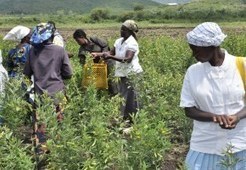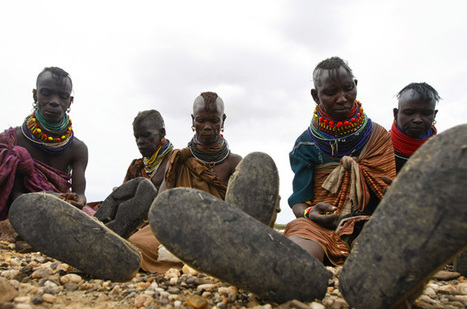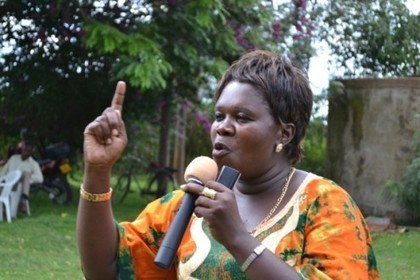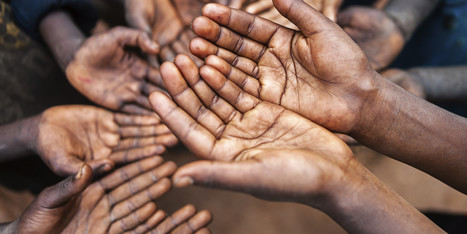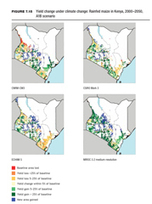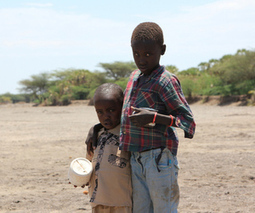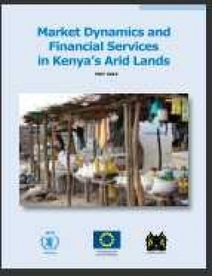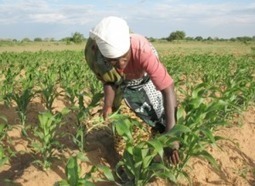 Your new post is loading...
 Your new post is loading...
Agriculture is the main economic activity for the more than 80 percent of the population in Kenya, with rural households drawing direct livelihoods from it.
Unfortunately, the small-scale farmers continue to solely depend on rain to carry out their farming activities, a reliability which has resulted to crop failures, thereby endangering household food security.
Faced with increasingly scorching heat and drought that have lasted two years in Kitui County in Eastern Kenya, a community banking group has moved their investments to a new climate-resilient currency: goats.
The small-scale farmers, who contribute funds to a savings pool and are eligible for small loans from it, aimed to use the funds to improve their farms and boost their harvests of hardy crops like pigeon pea
A new book, East African Agriculture and Climate Change, will help frame the discussion. Produced by the International Food Policy Research Institute (IFPRI) and the Association for Strengthening Agricultural Research in Eastern and Central Africa (ASARECA) with support from CCAFS, it includes a chapter focused solely on what might happen to farming in Kenya. Scientists developed four different scenarios, or "climate models," each revealing different outcomes for food production between now and 2050. One shows areas of the Rift Valley and coastal provinces becoming too hot or too dry to support maize cultivation.
Concern is growing in Kenya that these extremes are just the beginning of the consequences of climate change. In fact, there is considerable evidence that right now, and in the foreseeable future, the build-up of greenhouse gases in the upper atmosphere will progressively alter conditions for cultivating life-sustaining food crops like maize and wheat, and for raising cattle and other livestock. The government has seen the signs and responded accordingly. In 2012, it developed the Kenya Climate Change Action Plan. But what is still missing is a detailed strategy for keeping food production vibrant as the effects of climate change sweep across the country.
...So few people could have even dreamt that beneath the sun-scorched, cracked earth was enough water to supply this entire country of 41.6 million people for 70 years...
Last Wednesday, the government and the United Nations Educational, Scientific and Cultural Organisation (UNESCO) announced the discovery of an estimated 200 billion cubic metres of freshwater reserves in Turkana County's Lotikipi basin...
...In Kenya, all water resources belong to the state, and government agencies have to approve and issue permits for water use. But according to a 2011 World Bank report titled "Kenya - Groundwater governance case study", there is a limited understanding "of the land surface groundwater linkage among professionals in the relevant sectors, and as a consequence there is no strategic awareness of the need to protect groundwater resources"...
...The water discovery is the second major natural resource find in Turkana County. In March 2012, oil exploration company Tullow Oil announced the discovery of millions of barrels of oil in Turkana County's Lokichar basin. "We cannot take the same direction that the oil dialogue has taken. Since the oil in Turkana was discovered, investors have only been interested in finding out when the oil will start flowing. They are not talking about the benefits to the community"[Friends of Lake Turkana]...
...Economist Arthur Kimani agrees. "The government needs to help the community understand that beyond drinking the discovered water, money can also come out of this resource by, for instance, using the water to grow cash crops."
An official in the Ministry of Environment, Water and Natural Resources says the community will soon be receiving the new-found resource. "In fact, the Turkana people will get water in the next two weeks. We are also engaging the private sector for partnerships that are economically viable to the community.
...the Kenya Red Cross Society erected three large greenhouses, built an irrigation system, and supplied people with seeds, tools and training to grow fruit and vegetables... As part of the project, hundreds of pipes were laid, creating an irrigation system that transports water from the nearby Sabaki River. A nine-foot well was also built to collect rain water which can also be used in the greenhouses, where river water would be too dirty. The greenhouses are communally owned and run, and villagers can also pay for a plot of now fertile land to cultivate, growing anything from watermelon and bananas to maize and beans. And it's not just in Gandini where greenhouses are transforming lives. In the nearby coastal town of Malindi, an innovative project is giving hope to female prisoners. A large greenhouse has been built in the grounds of the low-security GK Women's prison, giving the 40 inmates who live there a chance to gain new skills that can help them get a job once they are released; skills that will help them look after their family's health and nutrition.
A new series of pilot projects in Northern Kenya will place greater decision-making powers about climate change adaptation into the hands of community members – a move backers hope will create sustainable solutions for area farmers and pastoralists... ...A Climate Adaptation Fund (CAF) will be set up this year in Garissa, Isiolo and Kitui Counties, with additional counties joining over the next three years. Regional decision makers will then determine the best way to disperse CAF money for climate adaptation projects, based on what their communities say they need.
INTERVIEW Africa has been hard hit by climate change. In recent years, the continent has stepped up efforts to use research and innovation to combat the problem. Kenya has seen the establishment of a Climate Innovation Center and an East Africa Climate Innovation Network. Last year, the African Union set up a science and technology advisory panel to develop a more Africa-centered research and development environment.
Kenyan-born Calestous Juma is professor of the Practice of International Development at Harvard where he directs the Science, Technology and Globalization Project, as well as the Agricultural Innovation in Africa Project. He is also the founding director of the African Centre for Technology Studies in Nairobi and co-chair of the African Union's Panel on Science, Technology and Innovation. He has written widely on science, technology and sustainable development.
To improve the working conditions of our women, we are going to bridge the gap between the smallholder women farmers in the village and the top decision-making organs at both the national and international levels," said Galgalo, one of the northeast region's first women graduates and a long-time advocate for women rights. The recently elected female MPs believe that, by acting as women's "champions" on climate change, they can generate political goodwill that will help strengthen livelihoods, food security and health throughout Kenyan society. They have committed to becoming ambassadors for the rights of women who are bearing the brunt of climate change, as highlighted by fellow "champions" at the grassroots level.
Kenya’s rural woman are grappling with numerous challenges, including poverty, preventable diseases and the impacts of climate shifts on farming and other aspects of their daily lives, yet they are always under-represented in decision making... ...This region has always enjoyed climatic conditions that were favorable for farming. But that is no longer the case, due to climate-related disasters such as prolonged dry spells, floods and landslides, Wambilianga observed. The shifting climate heaps an additional burden on women, who are also largely responsible for child care... ...The main aims of the Kenya Climate Justice Women Champions movement are to unite voices, lobby for space in climate change negotiations, and help women adapt to new climatic conditions by backing community-based groups....The partner MPs have already started collecting views from smallholder farmers through climate change advocacy forums organized by the KCJWC. The information gathered will be used to craft future policies on climate change. ...The group has already gained 426,000 female and 110,000 male members, who are working to promote climate- and gender-aware approaches across the country... ...women have begun boosting their incomes by planting drought-tolerant crops, growing indigenous vegetables for nutritional purposes – especially for children and people living with HIV/AIDS – and adopting green farming practices such as agroforestry.
By diversifying their income sources, farmers are also improving their resilience to climate change. As the weather fluctuates between excessive rain, to months of drought, keeping a few chickens, goats that produce milk, and managing bees for honey can be good supplements to the regular on-farm activities. These days, planting traditional crops like maize and potato, using traditional methods, can be a high-risk activity. Different sources of income and a reliable supply of food also means a better chance to battle hunger, improve incomes, and ensure nutrition for the whole family. Researchers are also learning from farmers as they test a portfolio of promising climate change adaptation, mitigation and risk management interventions. Taken together, “climate smart practices” are the building blocks of "climate smart villages". The villages will be innovative hubs where farmers take the lead to improve existing practices and adopt new ones, adapt to the changing climate along the way.
|
...Kenya provides a number of important examples of the power of giving. By July 2011, at least 3.75 million people in the northern part of Kenya were threatened with starvation because of drought. More than 385,000 children below the age of five in 13 districts suffered from acute malnutrition.
In response to this situation, the "Kenyans for Kenya" initiative was launched on July 27, 2011. Spearheaded by leading business and media entities and the Kenya Red Cross Society (KRCS), the aim was to raise Ksh500 million in four weeks for relief efforts. The campaign exceeded all expectations and raised more than Ksh1 billion ($10.5 million); 760,000 Kenyans made a contribution.
The challenge is to replicate and translate the experience of initiatives like this one into ongoing and proactive giving interventions, which not only generate significant resources for good causes, but also nurture public understanding of the issues of concern and contribute to a broad-based giving culture....
[The service being developed by Econet for Zimbabwe is similar to one which has been rolled out in KENYA by that country's leading operator, SAFARICOM.] Econet Wireless has developed a weather-indexed drought insurance service for small holder farmers. The service allows farmers to make a financial claim if their crops fail because of either inadequate or excessive rainfall.
Under the Econet scheme, which is part of a programme for farmers known as EcoFarmer, a farmer can buy insurance for as little as eight cents per day, which is deducted from their prepaid phone account during the agricultural season. If the rain does not fall, resulting in a drought, the farmer will be given as much as $100 for every 10 kg seed pack planted.
The key to the system is a highly innovative weather monitoring network which enables Econet to know exactly how much rain fell on the farmer's field.
Econet has also partnered with Seed Co to produce special seed packs that contain a small plastic container with a special number that the farmer must SMS to the network. As soon as Econet receives the number, they know exactly where the farmer is located.
The Econet base station in the farmer's area monitors weather patterns including rainfall, temperature and humidity. This information is used by weather experts to tell if there has been a drought in the area.
The system being built by Econet is intended to give farmers, particularly small holder farmers, what is known as "weather-indexed insurance cover". Agricultural experts have long called for the need to give small holder farmers access to insurance cover for their crops.
When a farmer can plant crops knowing that crop failure does not mean hunger for the family, they will be encouraged to plant more crops and therefore increase national production.
Climate change is expected to bring a shift in Kenya's cereal production, particularly for maize and wheat, as regions previously not conducive for growing these crops become more productive. Such areas could, between 2010 and 2050, become the country's new breadbaskets, say the authors of a new analysis... The analysis, East African Agriculture and Climate Change, was written by researchers from the International Food Policy and Research Institute (IFPRI) and the Association for Strengthening Agricultural Research in Eastern and Central Africa... ...experts say that Kenyan farmers -- given the right tools and know-how -- could not only survive but thrive in the face of climate change...Climate change might have adverse effects on farmers, but if they are given information and the right technological transfers to improve farming and change their farming methods, they can thrive... ...According to the UN Food and Agricultural Organization, maize, wheat and rice account for half the calories consumed globally. To help farmers adapt to the new weather patterns, the researchers recommend increased investment in irrigated agriculture and infrastructure to increase access to markets, coupled with a reduction in population growth.
Farmers in Kenya can potentially thrive even as climate changes, but their chances of success would be greatly enhanced with supportive policies and forward planning. The study, which was funded in part by the CGIAR Research Program on Climate Change, Agriculture and Food Security (CCAFS), offers a detailed snapshot of Kenyan agriculture now and predicts how shifting demographics and future growing conditions could affect food security and crop production. The analysis includes projections for crop yields, population growth, and income, as well as scenarios for climate change from four different models. When taken together, these projections reveal a number of insights about Kenya’s future...
Population rising but GDP must catch up
The report notes that populations are projected to rise anywhere from 75% to 150% by 2050, increasing pressure on productive resources, which could lead to food insecurity. There is also an increasing trend towards urbanization. Though GDP is on the rise, growth rates may remain very slow unless Kenya implements policies to stimulate economic growth while concurrently reducing the rate of population growth...
Scientists in Kenya have discovered a massive underground reserve that could allow the drought-ravaged country to meet its water needs for the next 70 years. Discovered in the desert of Kenya's Turkana region, the Lotikipi Basin Aquifer contains more than 200 billion cubic meters of fresh water, and is about the size of Rhode Island. All told, the region has at least 250 billion cubic meters of fresh water stored in underground reserves, which are replenished at a rate of 3.4 billion cubic meters per year. The discovery, first reported by ITV News, will be officially announced Wednesday by the Kenyan government and UNESCO, which helped realize the project with funding from the Japanese government... ...UNESCO is aware of the challenges that lie ahead, though it seems confident that this week's discovery could bode well for a region that has been crippled by drought. The Kenyan government has already announced plans to launch similar explorations in other parts of the country, pinning its hopes on [the lead scientist] and his mapping technology.
Takaful Insurance of Africa is launching a pilot project providing satellite date-based livestock insurance cover for pastoral livestock herders in the drought-prone drylands of northern Kenya’s Wajir County. The Takaful Livestock cover will provide livestock keepers in the county with covers against livestock deaths resulting from shortage of fodder due to prolonged dry weather. Those who subscribe to this insurance policy will receive payments if the forage available for their insured cattle, camels, sheep or goats falls below a given threshold, with assessment of the state of vegetative cover in the county determined by satellite data. Takaful Insurance is partnering in this project with the International Livestock Research Institute (ILRI) and MercyCorps. ILRI, under the leadership of Andrew Mude, is providing the satellite data and MercyCorps is coordinating public awareness campaigns.
The World Bank has approved 155 million U.S. dollars to help Kenya build its water infrastructure and new water sector institutions as the country strives to provide water for all citizens.
World Bank Country Director for Kenya said the International Development Association (IDA) credit will finance the first operation under the government’s Water Security and Climate Resilience Program, a long-term, transformational program aimed at achieving water security and resilience to climate variability and change throughout the country.
The study comprises three components; livelihood and gender, market and supply, and financial services.
The Danish Refugee Council (DRC) announced Monday (June 10th) the launch of a scholarship programme for Somalis in Kenya's Dadaab refugee camp complex, providing educational opportunities for youth and vocational training for adults. Some 2,450 Somalis will benefit from the project, named "Improving Resilience and Livelihood Opportunities for Refugees in Dadaab" and funded by the United Nations High Commissioner for Refugees. More than 1,087 will receive training and about 1,365 will be sent to Kenyan universities.
For most African countries, climate change has not only become a key policy priority as reflected in their national communications to the UNFCCC but also the reason for more concerted engagement in the global climate change debate. This may explain Kenya’s recent move to launch a national climate change action plan that will guide the transition of the country towards a low carbon climate resilient development pathway. Coming at the height of the recent political campaign season, this important document may not have been noticed by many. However, its relevance for Kenya’s future cannot be underestimated as it is an important milestone in Kenya’s attempt to tackle climate change issues. The plan lays out a policy road map for reducing the country’s vulnerability to climate change, while also acknowledging that without such action, the country’s development priorities aimed at transforming the country into a newly industrialising, middle-income country as envisaged under Vision 2030 will be hampered. Like most African countries, Kenya’s economy remains fragile due to the dependency on rain-fed agriculture which contributes upto 28.5 per cent of the Gross Domestic Product. Recent food shortages occasioned by droughts in most parts of the country point to the high level of vulnerability facing the agricultural sector
|



 Your new post is loading...
Your new post is loading...



